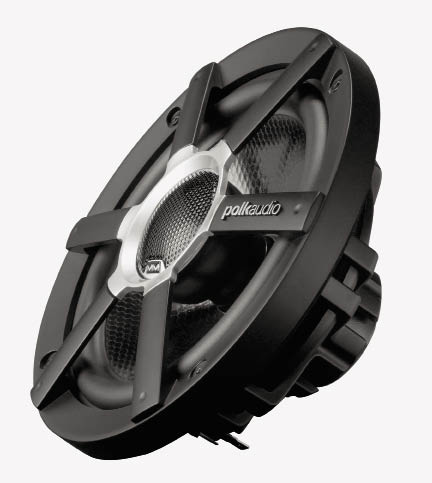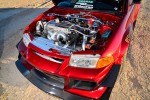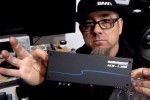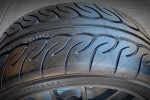Walk the halls of Polk Audio’s Baltimore headquarters, and you’ll meet sales people, engineers and technicians who also happen to be musicians, audiophiles, home theater  mavens, tube-equipment fanatics and rare vinyl LP collectors. There are folks here who plug in their instruments and throw down some self-penned tunes during meeting breaks, and women here who could teach courses on the physics of transducers. Everyone here brings something exciting to his or her job, whether it’s retail floor sales experience, a physics degree, knowledge of carpentry, a little black book of press contacts or some special marketing know-how. For all of us at Polk Audio, designing audio equipment is not just a job, it’s a passion. We wouldn’t have it any other way. Polk Audio offers three distinct series of loudspeakers for automotive and marine use, and this time we’re going to have a look at a pair of coaxials from the middle series, the MM651’s, which sell for the modest price of around $189.00 in the U.S.A. and about $219.00 in Canada.
mavens, tube-equipment fanatics and rare vinyl LP collectors. There are folks here who plug in their instruments and throw down some self-penned tunes during meeting breaks, and women here who could teach courses on the physics of transducers. Everyone here brings something exciting to his or her job, whether it’s retail floor sales experience, a physics degree, knowledge of carpentry, a little black book of press contacts or some special marketing know-how. For all of us at Polk Audio, designing audio equipment is not just a job, it’s a passion. We wouldn’t have it any other way. Polk Audio offers three distinct series of loudspeakers for automotive and marine use, and this time we’re going to have a look at a pair of coaxials from the middle series, the MM651’s, which sell for the modest price of around $189.00 in the U.S.A. and about $219.00 in Canada.
Design
The Polk MM651’s are sold as a 6.5-inch speaker designed to be a direct replacement for an OEM speaker, and provide high performance with outstanding reliability. To accomplish this, there are quite a few unusual and unique features on the MM series of drivers.
First, all of the Polk MM series speakers are fully marine rated. The speakers are all fully tested to withstand the harsh and extreme marine environment, and have undergone accelerated life tests for ultraviolet light, the corrosive effects of salt fog, and temperature extremes from -40° F to 185°F. When a speaker passes these tests, you know a life in your cars door panel is a walk in the park.
Another unique aspect of the MM series from Polk is the use of Polk’s Dynamic Balance technology. This technology is the result of a laser interferometry research project that was done in partnership with Johns Hopkins University. By using full field laser imaging, the engineers were able to closely view the entire vibrating surface of a driver or tweeter cone. The ability to watch various materials resonate allowed the design to be tweaked in a manner that reduced frequency response distortion. This tuning is accomplished by using just the right combinations of materials, geometry and construction techniques. Polk called this process Dynamic Balance.
Carrying on the high tech approach, the MM651’s utilize a carbon composite material for the basket, which provides high strength and stiffness, and is also more durable than a conventional stamped steel basket. Inside the high tech frame you’ll find an equally modern neodymium motor. Neodymium was chosen for its extreme magnetic strength, and because the motor can be made much smaller with the more powerful material, the motor structure is lighter weight, and the overall driver depth is reduced.
because the motor can be made much smaller with the more powerful material, the motor structure is lighter weight, and the overall driver depth is reduced.
The motor drives a 31mm (1.2-inch) oversized copper 3 ohm voice coil, which is in turn connected to a strong, yet very low mass honeycomb glass composite cone. The surround is Nitrile rubber, and the spider is made from Polyamide. If the 3 ohm coil got your attention, no need for concern… the Polk MM651’s are completely compatible with any 4 ohm capable amplifier. The advantage to the 3 ohm coil is increased sensitivity, which allows the speakers to be powered adequately with just a head unit or OEM amplifier. However, it does not mean you can’t use more power, and to that end the MM651’s are rated at 100 watts continuous.
The coaxial mounted 1-inch tweeter also uses a neo motor, and a bi-laminate silk dome for extended and smooth high frequency response. Unlike most coaxials, the Polk MM651’s come with an external 2-way crossover instead of some filter glued on the basket somewhere.
The MM series of speakers are modern looking bits of kit and have very good levels of fit and finish. Applications that have tight fit issues or problems with high weight speakers will be perfect for the MM651’s. They come with universal mounting rings that provide secure mounting into most OEM applications without drilling, and “spoke” styled grilles.
 mavens, tube-equipment fanatics and rare vinyl LP collectors. There are folks here who plug in their instruments and throw down some self-penned tunes during meeting breaks, and women here who could teach courses on the physics of transducers. Everyone here brings something exciting to his or her job, whether it’s retail floor sales experience, a physics degree, knowledge of carpentry, a little black book of press contacts or some special marketing know-how. For all of us at Polk Audio, designing audio equipment is not just a job, it’s a passion. We wouldn’t have it any other way. Polk Audio offers three distinct series of loudspeakers for automotive and marine use, and this time we’re going to have a look at a pair of coaxials from the middle series, the MM651’s, which sell for the modest price of around $189.00 in the U.S.A. and about $219.00 in Canada.
mavens, tube-equipment fanatics and rare vinyl LP collectors. There are folks here who plug in their instruments and throw down some self-penned tunes during meeting breaks, and women here who could teach courses on the physics of transducers. Everyone here brings something exciting to his or her job, whether it’s retail floor sales experience, a physics degree, knowledge of carpentry, a little black book of press contacts or some special marketing know-how. For all of us at Polk Audio, designing audio equipment is not just a job, it’s a passion. We wouldn’t have it any other way. Polk Audio offers three distinct series of loudspeakers for automotive and marine use, and this time we’re going to have a look at a pair of coaxials from the middle series, the MM651’s, which sell for the modest price of around $189.00 in the U.S.A. and about $219.00 in Canada. Design
The Polk MM651’s are sold as a 6.5-inch speaker designed to be a direct replacement for an OEM speaker, and provide high performance with outstanding reliability. To accomplish this, there are quite a few unusual and unique features on the MM series of drivers.
First, all of the Polk MM series speakers are fully marine rated. The speakers are all fully tested to withstand the harsh and extreme marine environment, and have undergone accelerated life tests for ultraviolet light, the corrosive effects of salt fog, and temperature extremes from -40° F to 185°F. When a speaker passes these tests, you know a life in your cars door panel is a walk in the park.
Another unique aspect of the MM series from Polk is the use of Polk’s Dynamic Balance technology. This technology is the result of a laser interferometry research project that was done in partnership with Johns Hopkins University. By using full field laser imaging, the engineers were able to closely view the entire vibrating surface of a driver or tweeter cone. The ability to watch various materials resonate allowed the design to be tweaked in a manner that reduced frequency response distortion. This tuning is accomplished by using just the right combinations of materials, geometry and construction techniques. Polk called this process Dynamic Balance.
Carrying on the high tech approach, the MM651’s utilize a carbon composite material for the basket, which provides high strength and stiffness, and is also more durable than a conventional stamped steel basket. Inside the high tech frame you’ll find an equally modern neodymium motor. Neodymium was chosen for its extreme magnetic strength, and
 because the motor can be made much smaller with the more powerful material, the motor structure is lighter weight, and the overall driver depth is reduced.
because the motor can be made much smaller with the more powerful material, the motor structure is lighter weight, and the overall driver depth is reduced. The motor drives a 31mm (1.2-inch) oversized copper 3 ohm voice coil, which is in turn connected to a strong, yet very low mass honeycomb glass composite cone. The surround is Nitrile rubber, and the spider is made from Polyamide. If the 3 ohm coil got your attention, no need for concern… the Polk MM651’s are completely compatible with any 4 ohm capable amplifier. The advantage to the 3 ohm coil is increased sensitivity, which allows the speakers to be powered adequately with just a head unit or OEM amplifier. However, it does not mean you can’t use more power, and to that end the MM651’s are rated at 100 watts continuous.
The coaxial mounted 1-inch tweeter also uses a neo motor, and a bi-laminate silk dome for extended and smooth high frequency response. Unlike most coaxials, the Polk MM651’s come with an external 2-way crossover instead of some filter glued on the basket somewhere.
The MM series of speakers are modern looking bits of kit and have very good levels of fit and finish. Applications that have tight fit issues or problems with high weight speakers will be perfect for the MM651’s. They come with universal mounting rings that provide secure mounting into most OEM applications without drilling, and “spoke” styled grilles.
Read on for the Results
Related Articles
 The Evolution of Archie Concon's 2000 Mitsubishi Mirage
The Evolution of Archie Concon's 2000 Mitsubishi Mirage
While the rest of the world received thinly disguised rally cars in the form of the first seven generations of the Lancer Evolution, we were stuck...
 Steve Meade Unboxes, Plays and Dyno Tests the AudioControl ACM Micro Amplifiers
Steve Meade Unboxes, Plays and Dyno Tests the AudioControl ACM Micro Amplifiers
Steve Meade of West Coast Car Audio is seen in this video unboxing, playing and dyno testing the micro AudioControl ACM 1.300 mirco amplifier...
 Yokohama Advan Neova AD08R Tire Review
Yokohama Advan Neova AD08R Tire Review
I attended an SCCA Track Night In America event at Portland International Raceway and had a chance to test out a set of Yokohama Advan Neova...
 Kenwood XR600-6DSP Amplifier Review
Kenwood XR600-6DSP Amplifier Review
Anyone who has ever attempted to upgrade a factory audio system with some real power knows the challenges involved.
Depending on the specific car,...
 Pioneer AVIC-8400 NEX DVD/NAV Receiver Review
Pioneer AVIC-8400 NEX DVD/NAV Receiver Review
Ah, technology.
While it’s a struggle to simply keep abreast of all the latest and greatest advancements, there’s no argument that technology is a...
 Do It First Or Do It Different: Ken Fuller - 2013 Hyundai Veloster Turbo
Do It First Or Do It Different: Ken Fuller - 2013 Hyundai Veloster Turbo
Photography by Alysia Fiebig
Ken Fuller once owned a 2006 Chevrolet Cobalt SS which was fairly modified, but he started to feel like he had gone...




